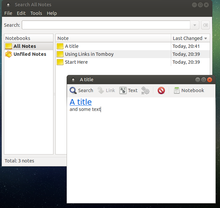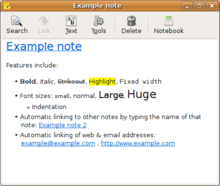Tomboy (software)
 | |
 Tomboy 1.15.4 running onUbuntu MATE | |
| Developer(s) | Alex Graveley and Tomboy Contributors |
|---|---|
| Stable release | |
| Repository | github |
| Written in | C# |
| Operating system | Windows,macOS,Linux,BSD |
| Platform | Mono |
| Type | Notetaking software |
| License | LGPL-2.1-only[3] |
| Website | projects |
Tomboyis afree and open-sourcedesktopnotetaking appwritten forWindows,macOS,Linux,andBSDoperating systems. Tomboy is part of theGNOMEdesktop environment. As Ubuntu changed over time and itscloudsynchronization softwareUbuntu Onecame and went, Tomboy inspired variousforksand clones. Its interface is a word processor with awiki-like linking systemto connect notes together. Words in the note body that match existing note titlesbecome hyperlinks automatically,making it simple to construct apersonal wiki.For example, repeated references to favorite artists would be automatically highlighted in notes containing their names. As of version 1.6 (2010), it supports text entries and hyperlinks to the World Wide Web, but not graphic image linking or embedding.
Development of the original Tomboy software ceased in 2017. Starting in 2017 the development team rewrote the software from scratch, for ease of maintenance and installation, renaming ittomboy-ng.[4]Tomboy-ng is written inFree Pascal.[5]
Features
[edit]
Some of the editing features supported:
- Text highlighting
- Inline spell checking using GtkSpell
- Automatic hyperlinkingof Web and email addresses
- Undo/redo
- Font styling and sizing
- Bulleted lists
- Note synchronization overSSH,WebDAV,Ubuntu One,or the Tomboy REST API[6]that is implemented by several server applications
Plugins
[edit]Tomboy supports several plugins, including:
- Evolutionmail links
- Galago/Pidginpresence
- Note of the day (disabled by default)
- Fixed width text
- HTMLexport
- LaTeXmath (in the packagetomboy-latex,not installed by default)
Ports
[edit]- Conboy:a Tomboy port to theMaemoplatform written in theClanguage[7][8]
- Gnote:a conversion of the Tomboy code to theC++language, but is not cross-platform
- libktomgirl:a platform-independent library that reads and writes the Tomboy File Format[9]
- Tomdroid:an effort to produce a Tomboy-compatbile notetaking app for theAndroidoperating system.[10][11]
See also
[edit]References
[edit]- ^"tomboy: Tomboy Notes".Retrieved1 January2018.
- ^"Release 1.15.9".16 July 2017.Retrieved15 November2020.
- ^"tomboy_1.14.1-4_copyright".
- ^"GNOME Wiki: tomboy-ng".Retrieved12 October2022.
- ^"tomboy-ng wiki: Building tomboy-ng".GitHub.Retrieved12 October2022.
- ^"Tomboy Web, A RESTful API for Tomboy Note Synchronization".2014-08-23.Retrieved2014-09-13.
- ^Conboy
- ^"garage: Conboy - Note Taking Application: Project Info".September 16, 2009.RetrievedSeptember 16,2009.
- ^"libktomgirl: An implementation of the Tomboy File Format in C++".GitHub.October 15, 2013.RetrievedOctober 15,2013.
- ^Tomdroid
- ^"Tomboy Notes on Android: Olivier Bilodeau Releases Tomdroid 0.1.0".April 21, 2009.RetrievedJanuary 3,2010.
